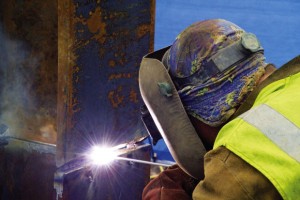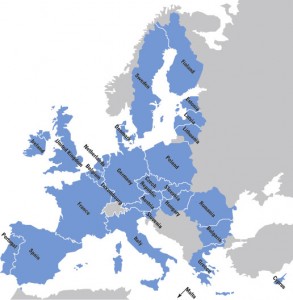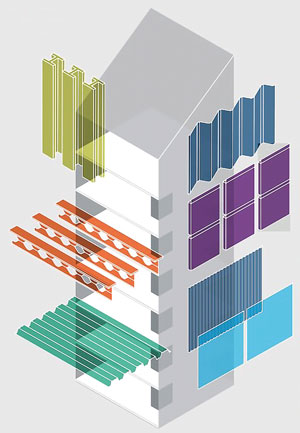Technical
CE Marking
Dr Roger Pope, BCSA Technical Consultant, explains what CE Marking will mean to the steel construction industry.
Public Safety
CE Marks have already appeared on some construction products and you may be wondering what it means for you. Let me start with the basics and then we can explore the implications.
Most of the manufactured products that you buy will already have CE Marks on them and we take this for granted. In essence it is a declaration by the manufacturer that the product meets certain regulatory requirements. For electrical goods this warranty by the manufacturer would include a declaration that the equipment was suitably earthed or insulated with the aim of preventing the user receiving an electric shock. For a toy teddy bear it would include a declaration that the eyes would withstand a certain pull to prevent a child detaching and swallowing them.
The theme that underlies such declarations is that the product meets specified public safety requirements which a spelt out in the relevant European Directive and promulgated in each EU country by parallel national regulations. The regulations then open up a direct path for national authorities to prosecute errant manufacturers. As with health & safety legislation, this would be a criminal prosecution and is totally independent of the contractual arrangements that exist between manufacturer and purchaser.
The Construction Products Directive was promulgated in 1988, and the UK’s Construction Product Regulations in 1991. Yes, the regulations have been in place for nearly 20 years yet most people working in the industry will not have seen any construction products bearing CE marks until recently! The reason for this is that manufacturers need what are termed harmonised product standards in order to quantify the declared product properties. Within the CPD are what are termed “essential requirements” which for steel products include mechanical resistance and stability, and fire resistance. The harmonised standards break down these general requirements into specific measurable properties termed “performance characteristics” such as yield strength, toughness and load bearing capacity. Then manufacturers can provide precise warranties that the product has a particular yield strength in accordance with the harmonised product standard.
The harmonised standard establishes the values to be met – for instance the required yield strength of nominal S275 steels reducing with thickness. Importantly it also defines the test methods and the testing frequency if sampling is adopted.
Certification
However for safety critical products like structural components, the manufacturer is not allowed to fix CE Marks without having suitable factory production control (FPC). This requires that a certification body needs to be satisfied that the manufacturer’s FPC is able to produce products that comply with the relevant harmonised standard referenced on the manufacturer’s CE Marking documentation.
The certification bodies themselves need to meet agreed European Standards for the integrity of their operations. Having satisfied, say, the United Kingdom Accreditation System, UKAS will notify the European Commission. By this process a certification body becomes a Notified Body (NB) that can certify FPC systems for particular harmonised standards. The Steel Construction Certification Scheme will become notified for BS EN 1090-1 as soon as this standard is published in 2008.
Under the system applicable to steel products, the NB is not required to make any declaration about the particular properties of the products themselves. The NB merely needs to be satisfied with the manufacturer’s processes of control. This is similar to way in which certification of the manufacturer’s quality system has been undertaken to BS EN ISO 9001 except in two important aspects:
- The 9001 certification was voluntary and manufacturers would not face a criminal prosecution for proven transgression;
- The FPC certification is not a general endorsement of the manufacturer’s management system but is specific to particular harmonised standards and these will be identified on the FPC certificate issued to the manufacturer.
This latter point is important as it is only by linking the certification to specific requirements in the harmonised standards that a “chain of custody” exists to provide assurance that the public safety provisions of the CPD are being met.
Trade Barriers
It will be apparent that all the above controls and assurances are focused on the factory and there is no mention of work undertaken on site. Similarly this article emphasises the role of the steelwork contractor as manufacturer or fabricator. This is because the reason that the Europe Community (as it then was) promulgated the CPD was in the furtherance of an efficient internal market by the removal of technical barriers to trade. The main concern was that all EC markets would be open to products manufactured in other EC countries. A study undertaken at the time showed the dysfunctional effect of such barriers with nearly identical products being sold with price disparities of as much as a factor of 10!
We can already see some evidence of successful trading in “catalogue” products on the shelves
of the builder’s merchants throughout Europe. Fabricated steel components are largely “bespoke” products made to a particular client’s order/ specification and designed for a particular site. The assumption might be that such a client and/or specifier the CE Mark adds nothing as they select the steelwork contractor rather than choosing an off-the-shelf product at a builder’s merchants.
The CE Mark does add the following to such a situation:
- The regulatory imperative from the CPD ensures attention is given to key public safety concerns that may have been ignored in the typical building contract – the “wider legacy” argument.
- The requirement for certification of the manufacturer’s FPC provides assurance of comparable and appropriate controls across the market place – the “level playing field” argument.
For steel products such as rolled steel beams to EN 10025-1, CE Marking is already a fact of life and the test /inspection certificates will now all be endorsed with a CE Mark. Similarly, structural fasteners to EN 14399-1 and 15048-1 will soon be appearing with CE Marks on the packaging. We will have to wait until the relevant harmonised standard, EN 1090-1, is notified in the Official Journal in late 2008 for CE Marks to appear on documentation accompanying fabricated structural components. What will that mean for fabrication?

To fix the CE Mark to welded structural components, manufacturers will need to demonstrate that their FPC meets the requirements given in 3834.
Steel Fabrication
The special process involved in fabrication is that of welding, and special attention is given to this in the harmonised standard. In terms of FPC for welding of structural steel components, the quality requirements are defined in EN ISO 3834. In order to be able to fix the CE Mark to welded structural components, manufacturers will need to demonstrate to a Notified Body that their FPC meets the requirements given in 3834.
In many ways, particularly for fabricators with existing 9001 certification, meeting the 3834 requirements should not prove problematic. There is one particular aspect that BCSA and the Welding Institute (TWI) are addressing, and that is the requirement for welding coordination. What 3834 requires is that welding coordination should be under the control of suitably competent personnel. Thus, the NB asked to certify that the FPC meets 3834 will need to be satisfied that the welding coordination personnel are competent to control the system, and at least one individual meeting the competence standard will be identified on the certificate issued by the NB as the Responsible Welding Coordinator (RWC).
So, the fabricator needs to identify at least one suitably competent welding specialist, and to
give them defined responsibilities and authority over all welding undertaken within the company’s factories. Importantly, the RWC does not have to be a full-time employee. With suitable organisational arrangements, a subcontract arrangement with an external specialist is sufficient if it is supported by less-qualified but responsible individuals running the day-to-day welding operations.
The standard requires that the competence of RWCs is assessed with respect to the system under their control. This is important as it limits the scope of knowledge, qualification and experience required. Typically the scope of the company’s operations will be defined by the parameters that appear on its portfolio of Welding Procedure Qualification Records (WPQRs), in particular parent metals and welding processes. The FPC certificate issued by the NB will thus not only identify the RWC but also the parent metals and welding processes under the RWC’s control.
Current Developments
Some have argued that the quality, reliability and price-competitiveness of steel product supply and fabrication in the UK did not need the CPD to ensure public safety or to level the playing field. There is merit in the argument that the BCSA’s national initiatives on quality management and the National Structural Steelwork Specification for Building Construction (NSSS) have been successful in this regard.
However, it is not open for particular sectors to opt out of national regulations, and the BCSA is thus concentrating on implementing the requirements positively. The steps being taken are:
• The latest edition of the NSSS now requires steelwork contractors to address and meet the appropriate requirements of 3834. This will prepare steelwork contractors for having their FPC systems certified to 3834 later next year.
• Establishing competence assessment procedures for RWCs jointly with TWI. The need for additional training is also being evaluated with TWI.
• Providing step-by-step guidance for fabricators on how to approach 3834 and CE Marking.
• Convening specialist groups dealing with fasteners and cold-formed products to address CE Marking issues specific to them.
The intent is to ensure that existing systems should be mobilised as far as possible to avoid CE Marking leading to additional bureaucracy. This was largely achieved by Corus in adapting their 9001 systems to meet FPC requirements. As noted above, BCSA has identified the additional requirements and is helping its members to address them.












